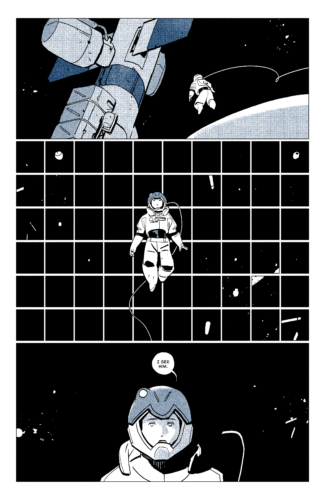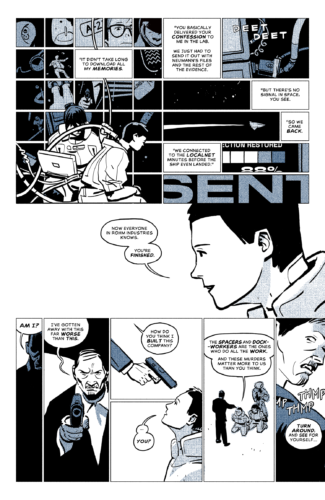Throughout the month of October, the Cartoonist Cooperative will be sharing interviews with members of the Co-op who have a new comic available at the ShortBox Comics Fair 2023!
NOTE: The Cartoonist Cooperative is not affiliated, associated, authorized, endorsed by, or in any way formally connected with ShortBox.

Cartoonist Cooperative: We’d love it if you could introduce yourself and tell us about your background in comics.
Tan Juan Gee: I’m Juan Gee, a Chinese Singaporean university student. I’ve been illustrating seriously for a few years for things like tabletop game rulebooks. I draw a wide variety of sci-fi and fantasy characters. Drawing comics is a more recent thing that I picked up during the pandemic; I got my start in a few OCTs (original character tournaments) here and there, which are usually short comics made on short deadlines. This ShortBox comic is the longest project I’ve had to draw, both length- and time-wise.
CC: Tell us more about your new comic!
TJG: A Three Body Problem is about a survey astronaut, Io, discovering the corpse of a private eye and realising they’re the same model of cyborg. She pieces together that this private eye was murdered to bury his last unsolved case; and so over the course of the comic she solves these two mysteries (with a little help from the private eye’s old friend Yanfei, a robot-doctor!). I made this comic mainly because I wanted to use robots as a metaphor to explore constructions of the self, and discuss labour under capitalism. These are staples of sci-fi, after all!

CC: What are some early experiences as a cartoonist that shaped you or your process?
TJG: One of my friends ran a comics workshop to get me into making comics, and they insisted on paying lots of attention to lettering and SFX. Now I make sure to leave space for text during my layouts, and I fuss a lot over drawing speech bubbles (especially the tails). It’s a good habit!
CC: Tell us about your creative process; how did you develop this comic and what are the steps you took to bring it to the final stage?
TJG: I’m the kind of artist who has to plan this out step-by-step; so I finalised my script, then did all the thumbnails in one big document, then inked one page a day until the comic was done. It’s probably why I gravitate a lot towards murder mysteries (apart from my love for the heavy blacks in noir art) – because they’re really plot-focused stories you have to plan top-down, starting with how and why the murder happens and how the case gets solved. Conversely, I’m not good at writing character-focused stories. I’m horrible at doing deep dives into the inner lives of characters, or writing dialogue between them. It’s something I’m working on!

CC: What were some challenges you faced with this comic and how did you overcome them?
TJG: Writing wise, my story ended up being a fun romp instead of a deep and cerebral one. It’s something I regret a little, because I think stories like these have a responsibility to explore social issues in nuanced and mature ways. This is especially true for ‘detective’ stories; because in these stories “justice” is dispensed by someone who has power granted to them by their position as a cop working to enforce law for the state. I settled on writing a story that turned this dynamic around; where the antagonist benefits from these kinds of institutions that reproduce systemic violence, and the MCs work outside this system instead. Of course, this raises big questions like: what does “justice” look like outside of these systems? How much systemic change can one individual’s intervention cause? I don’t feel satisfied with the answers I’ve brought up in my short story (in fact I leave the outcome quite open-ended), but at least it’s a first step for me writing-wise.
Art-wise, I definitely still struggle with backgrounds a lot! And even if my illustrations don’t show it, I’m not very good at posing characters in three-dimensional space. You can actually see my brush selection and art style change over the course of this comic. I suppose I did get better at drawing figures, but poor ability to draw backgrounds still haunts me…
CC: Can you talk about your visual style? How did you develop it?
TJG: I really like old American comics, as well as artists inspired by them today. I think their styles are really suited to draw comics with: heavy spot blacks, a flat brush to imply shadows, strong draftsmanship and anatomy that can be elegantly simplified. Elegant linework is also something that the European ligne-claire school shares with these artists, and definitely some older manga illustrators too. I guess my influences are quite wide! It’s probably because I tend to change up my inking and colouring approach for illustrations a lot, and it’s something you can see in my older comics too. You can see it affecting my paneling as well: aspect panels which convey mood show up a lot in my comics, which are less common in American comics but more common in manga. But I guess when I plan my layouts, I never think about my influences very consciously. It’s a messy struggle to fit the story onto the page.

CC: Can you tell us about your newest projects/projects you have in development? Feel free to plug anything here as well eg. socials, website, etc.
TLJ: Right now I’m busy with schoolwork, but I’m working on some mecha anthology comics written by Andrew Carl called Metal Rebellion. I’m doing a short comic or two about the poor unlucky pilots in this war story. As much as I like drawing mechanical objects, I know drawing robots will be another step up in difficulty that will definitely be a good learning experience. Exciting stuff!
You can see more of my work here at https://juangeedraws-portfolio.squarespace.com/, and I’m on various social media sites as @juangeedraws. Drop me a message anytime!









